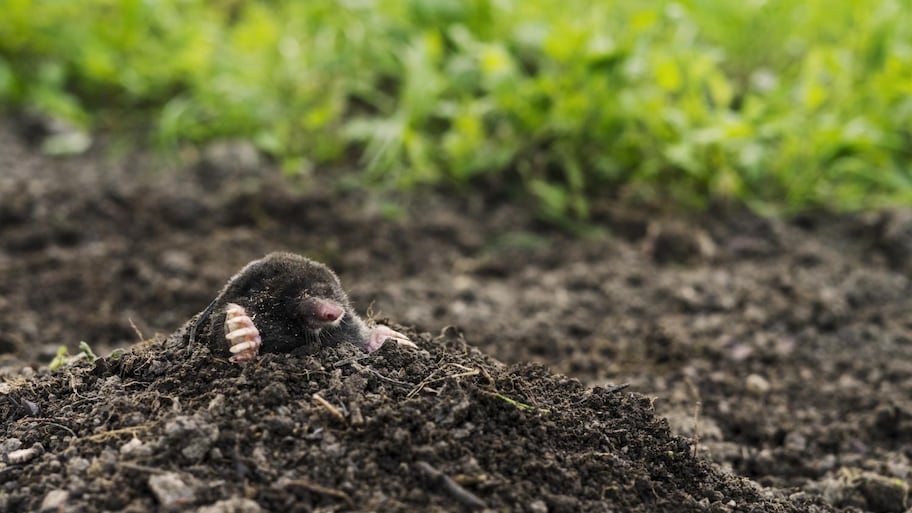Highlights
Mole removal costs $100–$550.
Moles can cause yard damage of $2,000 or more.
Bait is the least expensive removal option at $50.
Trapping is most effective and costs $150–$500.
If your yard is dotted with deep holes that are ruining your lawn and killing your plants, you could be dealing with pesky moles.
Although they are cute, these mammals can damage your landscape. Professional mole removal costs $400 on average. Extermination is usually less expensive, around $100, while live traps and relocation costs $300 to $550 but are more humane.
| National Average Cost | Minimum Cost | Maximum Cost |
|---|---|---|
| $400 | $100 | $550 |
How Much Does It Cost to Professionally Remove Moles?
Mole removal costs an average of $400 and usually depends on a cost-per-mole rate. If you’re dealing with a family of moles, you’ll spend more money, about $50 to $80 per mole, compared to if you’re dealing with just one pest.
Moles can damage plants’ root systems, your pristine green lawn, and even your yard equipment like mowers and sprinklers, so related repairs can cost an additional $2,000 or more.
Mole Removal Cost Breakdown
Much of the cost of professional mole removal goes to labor, and that’s because moles may fight back to defend the home they’ve made under your yard. It can be a dangerous job to remove moles.
Materials
The cost to remove moles can vary depending on the type of mole removal. Some services may exterminate the moles entirely, while others offer more humane options of trapping and relocating these mammals.
Kill traps: Trapping costs a set-up fee of $100 plus about $50 to $80 per mole. Traps are the most common and effective method of mole removal, but may not be for everyone.
Live traps: Live trapping moles is more difficult, as they live below ground, so this service will cost about $200 to $500.
Bait: Some services will set out poisonous bait, $50, to exterminate moles. This is less effective than traps or fumigation.
Fumigation: Exterminating moles via fumigation costs around $250. Fumigation is often used alongside trapping and is less effective on its own.
Labor
Mole removal is usually priced per mole at $50 to $80 each. Some companies may charge based on the number of trips they make to your property at $40 to $80 per visit, or you may have an average set-up fee of $100 that you pay upfront. Some pest removal services for moles and similar lawn foes offer regular monthly visits for around $600 per year.
Repairs and Replanting
If you have moles in your yard, the damage they can cause may lead to $2,000 or more in repairs. Moles dig underground and can disrupt your plants' root systems. Plus, they tear up the soil and grass in your lawn. Your beloved maple trees or your flower garden can be destroyed by moles.
Reseeding: Reseeding a lawn may cost $400 to $1,600. This service will help fix bare patches in the lawn caused by the moles’ digging.
Lawn repair: Aside from reseeding, you may spend up to $600 for lawn repairs, including aeration, filling mole tunnels, and fertilizing the lawn.
Sprinklers: Moles often cause damage to sprinklers, which cost around $250 to repair.
Replanting: For replanting, you may need to spend about $150 to $2,000 per tree and $1,000 or more for new plants around the yard, depending on the extent of the damage.
Cost to Remove Moles Yourself
Moles can become aggressive and may bite you if they feel threatened. That’s why it is best to hire a mole removal professional near you to take care of the pests in your yard. And if you’re dealing with shrews, some species are venomous, so always refer to a professional if you suspect shrew damage on your property.
How to Reduce Mole Removal Costs
While you shouldn’t attempt to remove moles yourself, there are ways to save money when dealing with these pests. If you have just one or two moles, bait can help remove the moles for a lower cost than trapping or fumigation. Another way to save money is to handle some of the lawn repairs yourself, such as aerating the lawn or replanting your flowers and trees.
Mole Removal Questions and Answers

What are the signs of a mole infestation?
Moles burrow tunnels underground in search of insects to eat. If moles have decided to call your property home, you may notice raised sections of the lawn, soft spots where the soil feels loose underfoot, dead patches of grass, or often mounds of soil where the moles enter or exit the lawn.
How do I prevent moles in my yard?
There are several ways to make your yard a less attractive habitat for moles. Protect your garden beds by installing a fence or other barrier about 2 to 3 feet deep around your garden.
Moles eat insects, so grub removal is another important way to prevent moles from destroying your yard. Likewise, remove tree stumps, dead leaves, and other debris that attract insects to your lawn.
Some plants will deter moles as well, including daffodils, marigolds, crown imperial, and alliums, like garlic or onions.
What are the differences between moles, voles, and shrews?
Moles, voles, and shrews are common lawn pests, but they aren’t quite the same. Moles live underground and feed on insects. They dig and move through tunnels underground, usually in meadows or forests but sometimes in lawns and gardens. They are about 6 inches long with large claws, tiny eyes, and hidden ears.
Shrews do not dig their own tunnels but will use other animals’ tunnels, and they are smaller than moles, about 3 to 4 inches long. They look similar to mice and feed on insects, like moles.
As for voles, these mammals are similar in size to moles but have large eyes and small but visible ears. Rather than eating insects, voles are herbivores that prefer seeds, grasses, and plant roots.
How much does mole removal cost by location?
Moles are common pests in the eastern U.S. and the area known as the Great Plains. Shrews, which are similar to moles but slightly smaller, are more commonly found in the southern and western U.S. Because of these differences, mole removal costs may vary depending on where you live.





